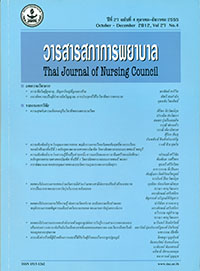ผลของโปรแกรมการสอนร่วมกับการมีส่วนร่วมของสามีต่อการปรับตัว ด้านบทบาทการเป็นมารดาของมารดาวัยรุ่นในระยะหลังคลอด
Abstract
บทคัดย่อ
การวิจัยกึ่งทดลองครั้งนี้ มีวัตถุประสงค์เพื่อศึกษาผลของโปรแกรมการสอน ร่วมกับการมีส่วนร่วมของสามีต่อการปรับตัวด้านบทบาทการเป็นมารดาของมารดาวัย รุ่น ในระยะหลังคลอด โดยใช้กรอบแนวคิดการปรับตัวของ Roy (2009) และบทบาทการเป็น มารดาของ Bobak and Jensen (1992) โดยศึกษาในมารดาวัยรุ่นหลังคลอดบุตรคนแรก 50 คนที่หอผู้ป่วยหลังคลอด โรงพยาบาลศิริราช โดยกลุ่มควบคุม 25 คนได้รับการพยาบาลตาม ปกติ ในระหว่างการวิจัยมารดาวัยรุ่นกลุ่มควบคุม 1 คน ปฏิบัติ กิจกรรมไม่ครบทุกขั้นตอน ส่วนกลุ่มทดลอง 25 คนได้รับการพยาบาลตามปกติและโปรแกรมการสอนร่วมกับการมีส่วน ร่วมของสามี ดังนั้นจำนวนกลุ่มตัวอย่างรวมทั้งสิ้น 49 คน เครื่องมือที่ใช้ในการวิจัย ประกอบ ด้วยโปรแกรมการสอนร่วมกับการมีส่วนร่วมของสามี แบบสัมภาษณ์ข้อมูลส่วนบุคคลแบบ สัมภาษณ์การปรับตัวด้านบทบาทของมารดาวัยรุ่นในระยะหลังคลอด สถิติ ที่ใช้ ในการวิ เคราะห์ ข้อมูลได้แก่ ความถี่ ร้อยละ ค่าเฉลี่ย ส่วนเบี่ยงเบนมาตรฐาน สถิติไคสแควร์ สถิติฟิชเชอร์ และสถิติที
ผลการวิจัย พบว่า มารดาวัยรุ่นในกลุ่มทดลองมีคะแนนการปรับตัวด้านบทบาทการ เป็นมารดาสูงกว่ากลุ่มควบคุมอย่างมีนัยสำคัญทางสถิติ ภายหลังคลอด 4 สัปดาห์ (p = .01) ดังนั้นพยาบาลประจำหน่วยหลังคลอดควรนำโปรแกรมการสอนร่วมกับการมีส่วนร่วม ของสามีไปใช้ส่งเสริมการปรับตัวด้านบทบาทการเป็นมารดาในระยะหลังคลอด ในด้านสัมพันธ์ ภาพระหว่างมารดากับบุตร และการเลี้ยงดูบุตรได้อย่างมีประสิทธิภาพ
คำสำคัญ : มารดาวัยรุ่นในระยะหลังคลอด, โปรแกรมการสอนร่วมกับการมีส่วนร่วมของสามี, การปรับตัวด้านบทบาทการเป็นมารดา
Abstract
The main purpose of this quass experimental research study was to examine the impact a teaching programme involving husbands’ participation had on teenage mothers’ post-childbirth maternity adjustment. The experiment was conducted according to the conceptual frameworks developed by Roy (2009) on self-adjustment and by Bobak and Jensen (1992) on maternity role.
The subjects were 50 first-time teenage mothers who had just given birth and were recuperating in the maternity ward, Siriraj Hospital. Of these, 25 mothers were placed in the controlled group and given normal nursing care. (During the experiment, however, one of the controlled group’s members failed to practice the complete set of activities, thereby re-ducing the number of subjects to 49.) The other 25 mothers, who belonged to the experi-mental group, were given a teaching programme that involved their husbands’ participation, in addition to normal nursing care.
The instruments used in this study consisted of a teaching programme designed to involve husbands’ participation, a personal profile interview form, and a form used to inter-view each teenage mother on her post-childbirth maternity adjustment. The data were sta-tistically analysed in terms of frequency, percentage, mean, standard deviation, Chi-Square statistics, Fischer statistics and T-statistics.
The study revealed that four weeks after childbirth, the mothers in the experimental group displayed a significantly higher maternity adjustment score than did their controlled group’s counterparts (p = .01). Therefore, it is recommended that nurses in charge of post-childbirth units apply a teaching programme that involved husbands’ participation to help mothers adjust themselves after giving birth, for enhanced mother-baby relationship and child-rearing efficiency.
Keywords : teenage mothers, post-childbirth, teaching programme involving husbands’ participation, maternity adjustment








